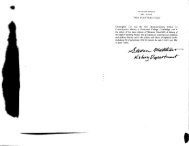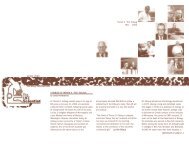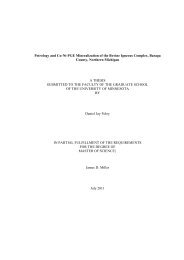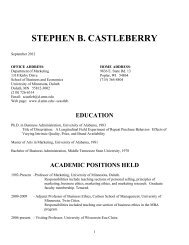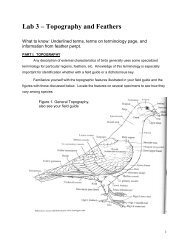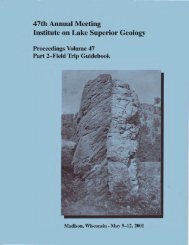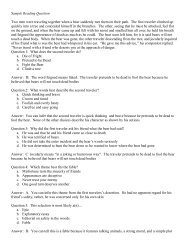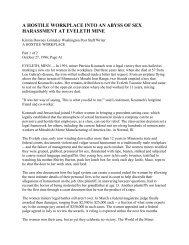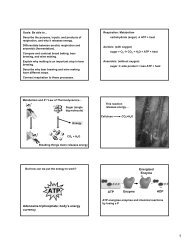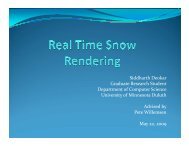Program, Abstracts, and Guidebooks - University of Minnesota Duluth
Program, Abstracts, and Guidebooks - University of Minnesota Duluth
Program, Abstracts, and Guidebooks - University of Minnesota Duluth
You also want an ePaper? Increase the reach of your titles
YUMPU automatically turns print PDFs into web optimized ePapers that Google loves.
—74—<br />
Most <strong>of</strong> the metavolcanic—metasedimentary sequence has been<br />
metamorphosed to greenschist facies but metamorphic grade increases<br />
southward within the Quetico belt (Macdonald, 1942; Peach, 1951).<br />
Structure<br />
The early Precambrian metavolcanic—metasedimentary sequence<br />
has been isoclinally folded along east—trending axes. Detailed<br />
work by Elorwood <strong>and</strong> Pye (1955) <strong>and</strong> Pye (1952), based on surface<br />
<strong>and</strong> subsurface mapping <strong>and</strong> geophysical data, outlined the style<br />
bf folding in the Geraldton area.<br />
Several prominent east—trending faults have been recognized.<br />
The Paint Lake fault is a major structural discontinuity in the<br />
Beardmore area <strong>and</strong> marks a change in both lithology <strong>and</strong> structural<br />
style. South <strong>of</strong> the fault, interbedded metasediments <strong>and</strong> mafic<br />
metavolcanic flows are folded along east—trending axes, but to<br />
the north, intermediate to felsic pyroclastic rocks predominate<br />
<strong>and</strong> fold axes trend north <strong>and</strong> northwest.<br />
Late Precambrian Rocks<br />
Relatively flat—lying sedimentary <strong>and</strong> volcanic rocks uncon—<br />
formably overlie Early Precambrian rocks in many places along the<br />
north shore <strong>of</strong> Lake Superior. Rare exposures <strong>of</strong> conglomerate,<br />
s<strong>and</strong>stone, shale, <strong>and</strong> dolomite <strong>of</strong> the Sibley Group are present in<br />
the western part <strong>of</strong> the Beardmore—Geraldton area near Lake Nipigon.<br />
Keweenawan diabase forms north—trending dikes throughout the<br />
Beardmore—Geraldton area <strong>and</strong> flat—lying sheets near Lake Nipigon.<br />
A diabase sheet, 400 to 650 feet thick forms a cuesta just east <strong>of</strong><br />
Beardmore. The sheet dips gently westward <strong>and</strong> at the Leitch Gold<br />
Mine, four miles west <strong>of</strong> Beardmore is 1871 feet below surface<br />
(Benedict <strong>and</strong> Titcomb, 1948; Ferguson, 1967). Porphyritic diabase<br />
dikes, locally known as "Greenspar porphyry" are thought to be<br />
older than the sheets <strong>and</strong> equigranular dikes.<br />
Late faulting has disrupted the Keweenawan diabase sheets <strong>and</strong><br />
dikes <strong>and</strong> probably represents reactivation <strong>of</strong> older faults.<br />
Pleistocene<br />
Thick deposits <strong>of</strong> s<strong>and</strong> <strong>and</strong> gravel are present throughout the<br />
belt <strong>and</strong> in some areas outcrop is scarce. Spillway channels, <strong>and</strong><br />
deltaic s<strong>and</strong> <strong>and</strong> valley train deposits have been outlined by Zoltai<br />
(1965). Wave—cut terraces <strong>and</strong> s<strong>and</strong> dunes are found near Lake<br />
Nipigon.<br />
ECONOMIC GEOLOGX<br />
Concentrations <strong>of</strong> gold, silver, iron, copper, nickel, molybdenum,




